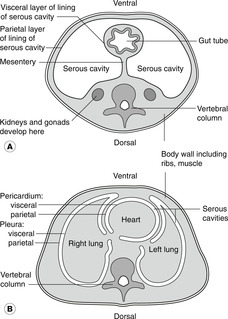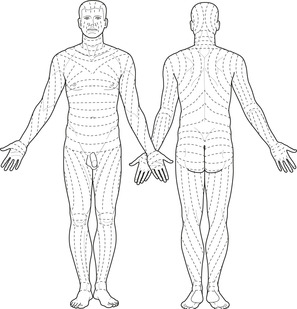A survey of the body15
3.2 Section through the trunk15
3.3 Fascia and layers16
3.4 Skin16
The human body is built like that of all vertebrates. The trunk consists of a body wall surrounding central cavities that exist in order to allow internal organs to move independently of the wall. These cavities are the pleural (for the lungs), pericardial (for the heart) and peritoneal (for the intestines). Limbs are outgrowths of the body wall. The head houses the brain and main sense organs, and at the other end of the trunk the perineum deals with body effluent and sexual function. The external aspect of the body is covered by skin and skin appendages.
You should:
• understand the trunk as a hollow container with walls
• understand that the limbs are outgrowths of the walls of the trunk
• list the names of the body cavities and serous membranes
• understand that the body wall contains skeletal tissue and muscle
• explain the difference between superficial and deep fascia.
3.1. A survey of the body
The anatomy of the human body is based upon the plan common to all vertebrates.
• The trunk (thorax, abdomen, pelvis) houses the internal organs (respiratory, digestive, urinary and internal genital).
• Limbs are outgrowths of the wall of the trunk. These are for locomotion, feeding and communicating.
• The head and neck house the brain and the entrance to the digestive and respiratory tracts. Since, in quadrupeds, the head leads the way into new environments, it also houses the special sense organs.
• The perineum, at the other end of the trunk, deals with the effluent from the digestive and urinary systems, and includes the external genitalia (in short, sphincters and sex). Many regard the perineum as part of the trunk.
• The nervous system serves all regions. The functions of the nervous system are control and communication.
• The vascular system serves all regions, delivering nutrients, removing waste products, acting as a transport medium and playing a part in other functions, such as communication (blushing).
3.2. Section through the trunk (Fig. 3.1)
Body wall
The body wall is composed of muscle and skeletal material (bone, cartilage) covered externally by skin. It encloses the serous cavities that contain the gut tube and its derivatives, and other internal organs.
Serous cavities: pleural, pericardial, peritoneal
Internal organs that require freedom to move are partially enclosed by a potential space, derived from the embryonic coelom, to facilitate this movement. This develops into the serous cavities (serous because they contain a small amount of lubricating fluid) and the membrane that lines such a cavity is a serous membrane. The serous cavities and membranes in the human are:
• pleural cavities (sometimes called thoracic cavities) permitting movement of lungs during breathing; serous membrane: pleura
• peritoneal or abdominopelvic cavity, permitting movement of intestines during digestion; serous membrane: peritoneum.
Serous membranes: parietal and visceral layers
The serous membranes secrete lubricating fluid.
• The layer of serous membrane that lines the body wall is the parietal layer.
• The layer of serous membrane that covers the surface of the internal organ is the visceral layer.
Figure 3.1 shows that these two parts are continuous at the point where the internal organ and body wall remain connected by tissue, allowing the passage of nerves, arteries, veins and lymphatics between the internal organ and the body wall. This connection is in some places (e.g. for some of the intestines in the abdomen) elongated to form a mesentery (Fig. 3.1A), a thin sheet covered on both sides by serous membrane, and in other sites the connection remains confined to a small area (e.g. for the lungs), the root or hilum (Fig. 3.1B).
3.3. Fascia and layers
Fascia is a term used in relation to the soft tissues of the body, and most often the body wall where it has two distinct meanings.
• Superficial fascia. This is simply loose connective and fatty tissue found immediately beneath the skin. It contains collagen, fat, elastic fibres, and connective tissue. It is variable in thickness: there are regional differences within an individual, and fat people have more than thin people.
• Deep fascia. This is a tough fibrous membrane that encircles compartments within the body, particularly in the limbs where it is attached to ridges on the limb bones. It forms partitions which create fascial compartments, sometimes important in limiting the spread of disease.
3.4. Skin
The skin is a barrier, an excretory organ (sodium), a synthetic organ (vitamin D), and a temperature control organ (sweating). The epithelium (external surface) of the skin is the epidermis. It is not necessary to spend much time on the skin except for a few points of clinical importance.
Langer’s lines
The orientation of connective and elastic tissue in the skin means that when it is cut in certain planes the edges will lie together, but when it is cut in other planes, the edges will gape. This is important in wound healing: a cut whose edges are gaping will heal less well and with more scarring than a cut whose edges lie together. The (invisible) cleavage lines along which cuts should be made for best healing are Langer’s lines and are as shown in Figure 3.2.
Appendages
These are nails, hair, teeth (some people would argue with this), and, in other creatures, horns, hooves and shells. It is worth noting that as you get older your nails become more and more like hooves, and in some cases become long, curved and tough so that they are extremely difficult to trim: onychogryphosis.
Glands
Glands opening onto the surface of the skin are exocrine glands.
• Sweat glands are for temperature control – sweating is a cooling mechanism – and are controlled by the sympathetic nervous system. They also excrete sodium chloride. In the external acoustic meatus (ear canal) these glands are called ceruminous glands because they produce wax (cerumen).
• Sebaceous glands are associated with hair follicles. The sebum they produce is for waterproofing. When their ducts become blocked, sebaceous cysts arise. A boil is an infected sebaceous gland.









